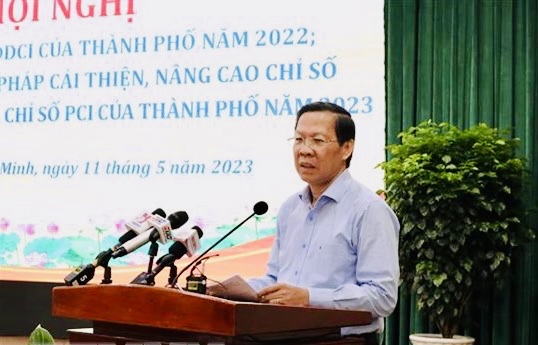 Society
Society


|
| Phan Văn Mãi, chairman of the People’s Committee, speaks at a meeting on Thursday to announce its 2022 Department and District Competitiveness Index results. VNA/VNS Photo |
HCM CITY — HCM City authorities plan this year to improve the city’s competitiveness to create the most favourable conditions for investment, production and businesses in all fields as it announced its 2022 Department and District Competitiveness Index (DDCI) results.
Speaking at a meeting to announce the results on Thursday, Phan Văn Mãi, chairman of the municipal People’s Committee, said in addition to the DDCI, the city would improve its Public Administration Reform Index (PAR Index), Public Administration Performance Index (PAPI), and Provincial Competitiveness Index (PCI).
To improve the PAR Index and PAPI, the city would focus on the major role played by and responsibility of leaders of departments, agencies, districts and Thủ Đức city.
To enhance the PCI index, it would improve its business climate, accelerate digital transformation and promote online public services.
Mãi has ordered departments, agencies, districts and Thủ Đức city authorities to develop plans to improve the indicators and report to the city by the end of the month.
“Improvement in the indicators will be the basis for evaluating the annual performance of departments, agencies and districts,” he noted.
DDCI results
According to the 2022 DDCI results, the Department of Science and Technology ranked first in the index, followed by the HCM City Export Processing and Industrial Zones Authority, the Department of Industry and Trade, the Department of Culture and Information, and the Department of Justice.
These departments also achieved high scores in criteria such as transparency and access to information, application of information technology and digital transformation, time cost, fair competition, business support, legal institutions, creative dynamism, and effectiveness.
Meanwhile, the Department of Labour, Invalids, and Social Affairs is at the bottom, ahead of the Department of Natural Resources and Environment and the Department of Transport.
The three departments of Health, Tourism, and Education and Training had failed to provide sufficient information for the evaluation, which was condemned by the city government.
Regarding districts, Phú Nhuận District led the overall index with a score of 78.56, followed by District 11, District 10 and Tân Phú District.
Meanwhile, Thủ Đức city (Việt Nam’s first city within a city by merging HCM City’s districts 2 and 9 and Thủ Đức District in 2020) is at the bottom, ahead of Bình Chánh and Củ Chi districts.
More than 15,000 firms, cooperatives, and business households were invited to join the survey from last December to the end of January this year.
The index evaluated 22 districts, including Thủ Đức city, and 17 departments based on nine indicators.
They include transparency and access to information (which accounts for 10 per cent of the ranking), information-technology application and digital transformation (10 per cent), unofficial costs such as bribes (10 per cent), time spent on administrative procedures (15 per cent), fair competition (10 per cent), support for business (10 per cent), legal institutions (5 per cent), the dynamism, creativity and effectiveness of departments, divisions and sectors (15 per cent), and the role of leadership (15 per cent).

|
| A view of HCM City. The city plans this year to improve its competitiveness to create the most favourable conditions for investors. Photo idj.com.vn |
In addition, land access and land use stability were also taken into consideration when assessing the localities.
The city had some of the lowest scores for transparency and access to information, land access and stability, unofficial costs, support for businesses, time expenditure, and the role of leadership.
The index aims to help departments, agencies and districts recognise their strengths and weaknesses so they can adjust to create a more friendly environment for investment, production and business activities in all fields. — VNS




